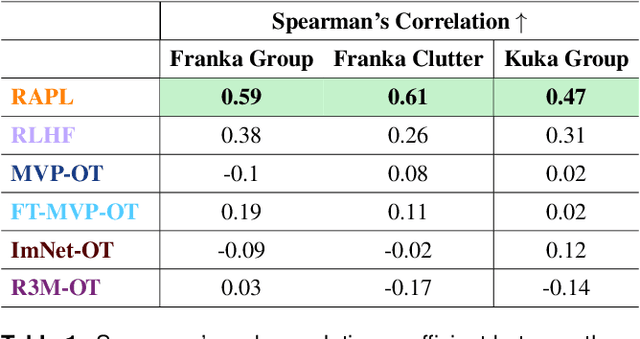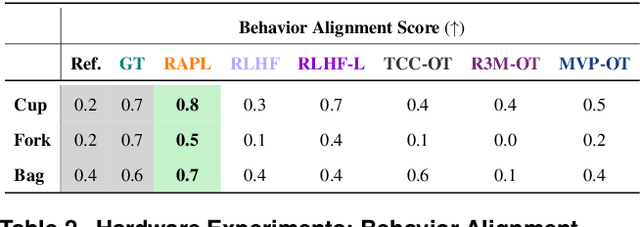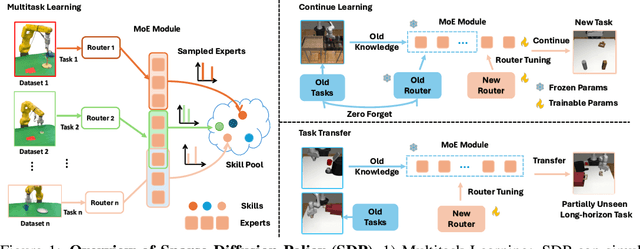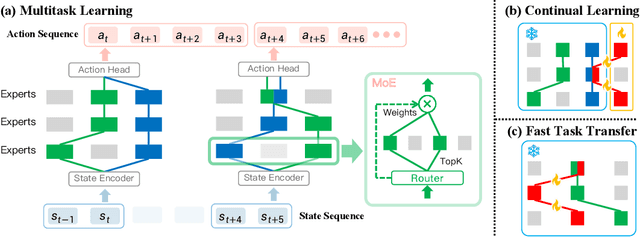Ran Tian
QuantV2X: A Fully Quantized Multi-Agent System for Cooperative Perception
Sep 03, 2025Abstract:Cooperative perception through Vehicle-to-Everything (V2X) communication offers significant potential for enhancing vehicle perception by mitigating occlusions and expanding the field of view. However, past research has predominantly focused on improving accuracy metrics without addressing the crucial system-level considerations of efficiency, latency, and real-world deployability. Noticeably, most existing systems rely on full-precision models, which incur high computational and transmission costs, making them impractical for real-time operation in resource-constrained environments. In this paper, we introduce \textbf{QuantV2X}, the first fully quantized multi-agent system designed specifically for efficient and scalable deployment of multi-modal, multi-agent V2X cooperative perception. QuantV2X introduces a unified end-to-end quantization strategy across both neural network models and transmitted message representations that simultaneously reduces computational load and transmission bandwidth. Remarkably, despite operating under low-bit constraints, QuantV2X achieves accuracy comparable to full-precision systems. More importantly, when evaluated under deployment-oriented metrics, QuantV2X reduces system-level latency by 3.2$\times$ and achieves a +9.5 improvement in mAP30 over full-precision baselines. Furthermore, QuantV2X scales more effectively, enabling larger and more capable models to fit within strict memory budgets. These results highlight the viability of a fully quantized multi-agent intermediate fusion system for real-world deployment. The system will be publicly released to promote research in this field: https://github.com/ucla-mobility/QuantV2X.
Direct Post-Training Preference Alignment for Multi-Agent Motion Generation Models Using Implicit Feedback from Pre-training Demonstrations
Mar 25, 2025Abstract:Recent advancements in LLMs have revolutionized motion generation models in embodied applications. While LLM-type auto-regressive motion generation models benefit from training scalability, there remains a discrepancy between their token prediction objectives and human preferences. As a result, models pre-trained solely with token-prediction objectives often generate behaviors that deviate from what humans would prefer, making post-training preference alignment crucial for producing human-preferred motions. Unfortunately, post-training alignment requires extensive preference rankings of motions generated by the pre-trained model, which are costly to annotate, especially in multi-agent settings. Recently, there has been growing interest in leveraging pre-training demonstrations to scalably generate preference data for post-training alignment. However, these methods often adopt an adversarial assumption, treating all pre-trained model-generated samples as unpreferred examples. This adversarial approach overlooks the valuable signal provided by preference rankings among the model's own generations, ultimately reducing alignment effectiveness and potentially leading to misaligned behaviors. In this work, instead of treating all generated samples as equally bad, we leverage implicit preferences encoded in pre-training demonstrations to construct preference rankings among the pre-trained model's generations, offering more nuanced preference alignment guidance with zero human cost. We apply our approach to large-scale traffic simulation and demonstrate its effectiveness in improving the realism of pre-trained model's generated behaviors, making a lightweight 1M motion generation model comparable to SOTA large imitation-based models by relying solely on implicit feedback from pre-training demonstrations, without additional post-training human preference annotations or high computational costs.
From Foresight to Forethought: VLM-In-the-Loop Policy Steering via Latent Alignment
Feb 03, 2025Abstract:While generative robot policies have demonstrated significant potential in learning complex, multimodal behaviors from demonstrations, they still exhibit diverse failures at deployment-time. Policy steering offers an elegant solution to reducing the chance of failure by using an external verifier to select from low-level actions proposed by an imperfect generative policy. Here, one might hope to use a Vision Language Model (VLM) as a verifier, leveraging its open-world reasoning capabilities. However, off-the-shelf VLMs struggle to understand the consequences of low-level robot actions as they are represented fundamentally differently than the text and images the VLM was trained on. In response, we propose FOREWARN, a novel framework to unlock the potential of VLMs as open-vocabulary verifiers for runtime policy steering. Our key idea is to decouple the VLM's burden of predicting action outcomes (foresight) from evaluation (forethought). For foresight, we leverage a latent world model to imagine future latent states given diverse low-level action plans. For forethought, we align the VLM with these predicted latent states to reason about the consequences of actions in its native representation--natural language--and effectively filter proposed plans. We validate our framework across diverse robotic manipulation tasks, demonstrating its ability to bridge representational gaps and provide robust, generalizable policy steering.
Maximizing Alignment with Minimal Feedback: Efficiently Learning Rewards for Visuomotor Robot Policy Alignment
Dec 06, 2024



Abstract:Visuomotor robot policies, increasingly pre-trained on large-scale datasets, promise significant advancements across robotics domains. However, aligning these policies with end-user preferences remains a challenge, particularly when the preferences are hard to specify. While reinforcement learning from human feedback (RLHF) has become the predominant mechanism for alignment in non-embodied domains like large language models, it has not seen the same success in aligning visuomotor policies due to the prohibitive amount of human feedback required to learn visual reward functions. To address this limitation, we propose Representation-Aligned Preference-based Learning (RAPL), an observation-only method for learning visual rewards from significantly less human preference feedback. Unlike traditional RLHF, RAPL focuses human feedback on fine-tuning pre-trained vision encoders to align with the end-user's visual representation and then constructs a dense visual reward via feature matching in this aligned representation space. We first validate RAPL through simulation experiments in the X-Magical benchmark and Franka Panda robotic manipulation, demonstrating that it can learn rewards aligned with human preferences, more efficiently uses preference data, and generalizes across robot embodiments. Finally, our hardware experiments align pre-trained Diffusion Policies for three object manipulation tasks. We find that RAPL can fine-tune these policies with 5x less real human preference data, taking the first step towards minimizing human feedback while maximizing visuomotor robot policy alignment.
Wolf: Captioning Everything with a World Summarization Framework
Jul 26, 2024



Abstract:We propose Wolf, a WOrLd summarization Framework for accurate video captioning. Wolf is an automated captioning framework that adopts a mixture-of-experts approach, leveraging complementary strengths of Vision Language Models (VLMs). By utilizing both image and video models, our framework captures different levels of information and summarizes them efficiently. Our approach can be applied to enhance video understanding, auto-labeling, and captioning. To evaluate caption quality, we introduce CapScore, an LLM-based metric to assess the similarity and quality of generated captions compared to the ground truth captions. We further build four human-annotated datasets in three domains: autonomous driving, general scenes, and robotics, to facilitate comprehensive comparisons. We show that Wolf achieves superior captioning performance compared to state-of-the-art approaches from the research community (VILA1.5, CogAgent) and commercial solutions (Gemini-Pro-1.5, GPT-4V). For instance, in comparison with GPT-4V, Wolf improves CapScore both quality-wise by 55.6% and similarity-wise by 77.4% on challenging driving videos. Finally, we establish a benchmark for video captioning and introduce a leaderboard, aiming to accelerate advancements in video understanding, captioning, and data alignment. Leaderboard: https://wolfv0.github.io/leaderboard.html.
Sparse Diffusion Policy: A Sparse, Reusable, and Flexible Policy for Robot Learning
Jul 01, 2024



Abstract:The increasing complexity of tasks in robotics demands efficient strategies for multitask and continual learning. Traditional models typically rely on a universal policy for all tasks, facing challenges such as high computational costs and catastrophic forgetting when learning new tasks. To address these issues, we introduce a sparse, reusable, and flexible policy, Sparse Diffusion Policy (SDP). By adopting Mixture of Experts (MoE) within a transformer-based diffusion policy, SDP selectively activates experts and skills, enabling efficient and task-specific learning without retraining the entire model. SDP not only reduces the burden of active parameters but also facilitates the seamless integration and reuse of experts across various tasks. Extensive experiments on diverse tasks in both simulations and real world show that SDP 1) excels in multitask scenarios with negligible increases in active parameters, 2) prevents forgetting in continual learning of new tasks, and 3) enables efficient task transfer, offering a promising solution for advanced robotic applications. Demos and codes can be found in https://forrest-110.github.io/sparse_diffusion_policy/.
Tokenize the World into Object-level Knowledge to Address Long-tail Events in Autonomous Driving
Jul 01, 2024Abstract:The autonomous driving industry is increasingly adopting end-to-end learning from sensory inputs to minimize human biases in system design. Traditional end-to-end driving models, however, suffer from long-tail events due to rare or unseen inputs within their training distributions. To address this, we propose TOKEN, a novel Multi-Modal Large Language Model (MM-LLM) that tokenizes the world into object-level knowledge, enabling better utilization of LLM's reasoning capabilities to enhance autonomous vehicle planning in long-tail scenarios. TOKEN effectively alleviates data scarcity and inefficient tokenization by leveraging a traditional end-to-end driving model to produce condensed and semantically enriched representations of the scene, which are optimized for LLM planning compatibility through deliberate representation and reasoning alignment training stages. Our results demonstrate that TOKEN excels in grounding, reasoning, and planning capabilities, outperforming existing frameworks with a 27% reduction in trajectory L2 error and a 39% decrease in collision rates in long-tail scenarios. Additionally, our work highlights the importance of representation alignment and structured reasoning in sparking the common-sense reasoning capabilities of MM-LLMs for effective planning.
MEReQ: Max-Ent Residual-Q Inverse RL for Sample-Efficient Alignment from Intervention
Jun 24, 2024Abstract:Aligning robot behavior with human preferences is crucial for deploying embodied AI agents in human-centered environments. A promising solution is interactive imitation learning from human intervention, where a human expert observes the policy's execution and provides interventions as feedback. However, existing methods often fail to utilize the prior policy efficiently to facilitate learning, thus hindering sample efficiency. In this work, we introduce MEReQ (Maximum-Entropy Residual-Q Inverse Reinforcement Learning), designed for sample-efficient alignment from human intervention. Instead of inferring the complete human behavior characteristics, MEReQ infers a residual reward function that captures the discrepancy between the human expert's and the prior policy's underlying reward functions. It then employs Residual Q-Learning (RQL) to align the policy with human preferences using this residual reward function. Extensive evaluations on simulated and real-world tasks demonstrate that MEReQ achieves sample-efficient policy alignment from human intervention.
A General Calibrated Regret Metric for Detecting and Mitigating Human-Robot Interaction Failures
Mar 07, 2024



Abstract:Robot decision-making increasingly relies on expressive data-driven human prediction models when operating around people. While these models are known to suffer from prediction errors in out-of-distribution interactions, not all prediction errors equally impact downstream robot performance. We identify that the mathematical notion of regret precisely characterizes the degree to which incorrect predictions of future interaction outcomes degraded closed-loop robot performance. However, canonical regret measures are poorly calibrated across diverse deployment interactions. We extend the canonical notion of regret by deriving a calibrated regret metric that generalizes from absolute reward space to probability space. With this transformation, our metric removes the need for explicit reward functions to calculate the robot's regret, enables fairer comparison of interaction anomalies across disparate deployment contexts, and facilitates targetted dataset construction of "system-level" prediction failures. We experimentally quantify the value of this high-regret interaction data for aiding the robot in improving its downstream decision-making. In a suite of closed-loop autonomous driving simulations, we find that fine-tuning ego-conditioned behavior predictors exclusively on high-regret human-robot interaction data can improve the robot's overall re-deployment performance with significantly (77%) less data.
Open X-Embodiment: Robotic Learning Datasets and RT-X Models
Oct 17, 2023



Abstract:Large, high-capacity models trained on diverse datasets have shown remarkable successes on efficiently tackling downstream applications. In domains from NLP to Computer Vision, this has led to a consolidation of pretrained models, with general pretrained backbones serving as a starting point for many applications. Can such a consolidation happen in robotics? Conventionally, robotic learning methods train a separate model for every application, every robot, and even every environment. Can we instead train generalist X-robot policy that can be adapted efficiently to new robots, tasks, and environments? In this paper, we provide datasets in standardized data formats and models to make it possible to explore this possibility in the context of robotic manipulation, alongside experimental results that provide an example of effective X-robot policies. We assemble a dataset from 22 different robots collected through a collaboration between 21 institutions, demonstrating 527 skills (160266 tasks). We show that a high-capacity model trained on this data, which we call RT-X, exhibits positive transfer and improves the capabilities of multiple robots by leveraging experience from other platforms. More details can be found on the project website $\href{https://robotics-transformer-x.github.io}{\text{robotics-transformer-x.github.io}}$.
 Add to Chrome
Add to Chrome Add to Firefox
Add to Firefox Add to Edge
Add to Edge